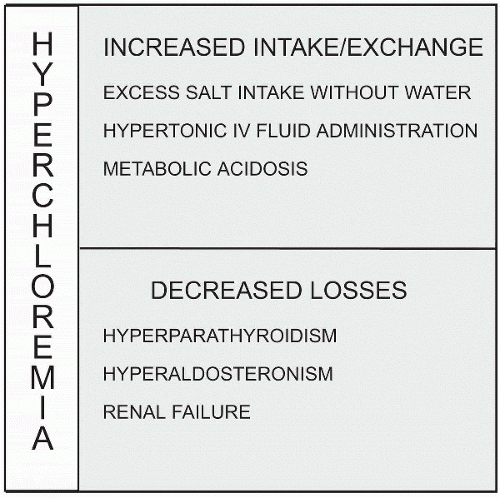Hyperchloremia
QUICK LOOK AT THE CHAPTER AHEAD
Hyperchloremia is an excess amount of chloride in the blood. A level exceeding 106 mEq/L in the extracellular fluid constitutes a hyperchloremic condition. A hyperchloremic imbalance is usually due to an underlying condition, without signs and symptoms of its own. Here we define the causes, manifestations, and treatment for this electrolyte disorder.
Hyperchloremia is an excess amount of chloride in the blood. A level exceeding 106 mEq/L in the extracellular fluid constitutes a hyperchloremic condition. Chloride has an affinity for sodium and an inverse relationship with bicarbonate. These relationships are reflected in a chloride imbalance. High levels of chloride are related to excess sodium or decreased bicarbonate levels in the body. In addition, the renal system controls the elimination of chloride from the body; therefore an imbalance with serum chloride levels may be related to kidney disfunction.
 A level exceeding 106 mEq/L in the extracellular fluid constitutes a hyperchloremic condition.
A level exceeding 106 mEq/L in the extracellular fluid constitutes a hyperchloremic condition.Hyperchloremia can result from an increased intake orally or via administration of hypertonic intravenous fluids of sodium chloride coupled
with a loss of water. Because of chloride‘s inverse relationship with bicarbonate, hyperchloremia occurs in conditions of metabolic acidosis, when serum bicarbonate levels are low (see Chapter 30). Endocrine conditions such as hyperparathyroidism, hyperaldosteronism, or diabetes insipidus may be the cause of hyperchloremia, as well as hypernatremia, due to the ability of chloride to bind with sodium (Table 21-1).
with a loss of water. Because of chloride‘s inverse relationship with bicarbonate, hyperchloremia occurs in conditions of metabolic acidosis, when serum bicarbonate levels are low (see Chapter 30). Endocrine conditions such as hyperparathyroidism, hyperaldosteronism, or diabetes insipidus may be the cause of hyperchloremia, as well as hypernatremia, due to the ability of chloride to bind with sodium (Table 21-1).
Stay updated, free articles. Join our Telegram channel

Full access? Get Clinical Tree



